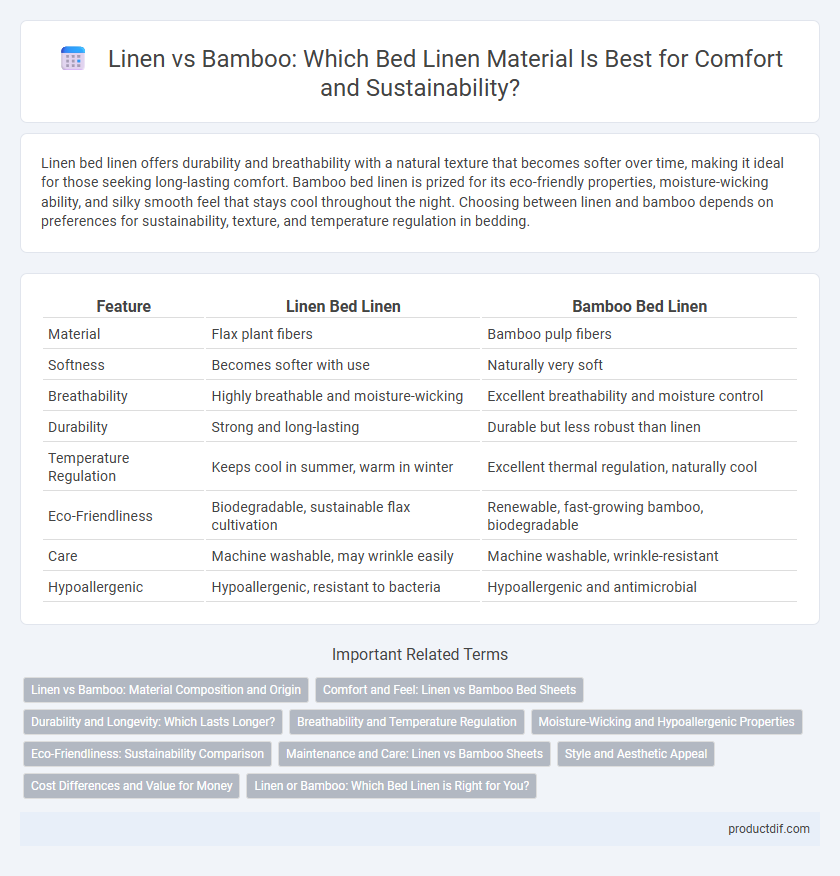Linen bed linen offers durability and breathability with a natural texture that becomes softer over time, making it ideal for those seeking long-lasting comfort. Bamboo bed linen is prized for its eco-friendly properties, moisture-wicking ability, and silky smooth feel that stays cool throughout the night. Choosing between linen and bamboo depends on preferences for sustainability, texture, and temperature regulation in bedding.
Table of Comparison
| Feature | Linen Bed Linen | Bamboo Bed Linen |
|---|---|---|
| Material | Flax plant fibers | Bamboo pulp fibers |
| Softness | Becomes softer with use | Naturally very soft |
| Breathability | Highly breathable and moisture-wicking | Excellent breathability and moisture control |
| Durability | Strong and long-lasting | Durable but less robust than linen |
| Temperature Regulation | Keeps cool in summer, warm in winter | Excellent thermal regulation, naturally cool |
| Eco-Friendliness | Biodegradable, sustainable flax cultivation | Renewable, fast-growing bamboo, biodegradable |
| Care | Machine washable, may wrinkle easily | Machine washable, wrinkle-resistant |
| Hypoallergenic | Hypoallergenic, resistant to bacteria | Hypoallergenic and antimicrobial |
Linen vs Bamboo: Material Composition and Origin
Linen is made from fibers of the flax plant, primarily cultivated in Europe, especially Belgium and France, known for its durability and breathability. Bamboo fabric originates from bamboo grass, predominantly grown in China and Southeast Asia, offering natural antibacterial properties and moisture-wicking capabilities. Both materials present eco-friendly benefits but differ significantly in texture and production processes.
Comfort and Feel: Linen vs Bamboo Bed Sheets
Linen bed sheets offer a textured, breathable surface known for moisture-wicking properties, ideal for hot sleepers seeking natural cooling. Bamboo bed sheets provide a silky-smooth touch with excellent softness and hypoallergenic qualities, enhancing comfort for sensitive skin. Both materials excel in durability and temperature regulation, but bamboo leans towards a more luxurious feel while linen emphasizes rustic, airy comfort.
Durability and Longevity: Which Lasts Longer?
Linen bed linen stands out for its exceptional durability, often lasting decades due to its strong flax fibers that resist wear and tear. Bamboo bed linen, while soft and biodegradable, tends to have a shorter lifespan because its viscose fibers are less resilient over time. Choosing linen ensures long-term use and sustained quality, making it the superior option for longevity in bedding.
Breathability and Temperature Regulation
Linen bed linen offers exceptional breathability due to its natural fiber structure, allowing air to flow freely and moisture to evaporate quickly, making it ideal for hot sleepers. Bamboo fabric excels in temperature regulation by wicking moisture away from the skin and maintaining a cool, dry sleep environment through its thermo-regulating and hypoallergenic properties. Both materials create comfortable bedding options, with linen favoring superior airflow and bamboo providing consistent cooling effects throughout the night.
Moisture-Wicking and Hypoallergenic Properties
Linen excels in moisture-wicking due to its natural fiber structure, allowing efficient breathability and keeping sleepers cool and dry. Bamboo fabric is highly hypoallergenic, naturally resisting bacteria and allergens, making it ideal for sensitive skin. Both materials offer excellent moisture management, but bamboo's antimicrobial properties provide an added benefit for allergy sufferers.
Eco-Friendliness: Sustainability Comparison
Linen, made from flax plants, is highly eco-friendly due to its low water and pesticide requirements, requiring less energy in production compared to conventional fabrics. Bamboo fabric offers significant sustainability benefits, as bamboo grows rapidly without fertilizers and absorbs large amounts of carbon dioxide, but its chemical-intensive processing can impact environmental friendliness. Both materials present sustainable options for bed linen, with linen favored for minimal processing and bamboo prized for fast renewability, making consumer choice dependent on manufacturing practices.
Maintenance and Care: Linen vs Bamboo Sheets
Linen sheets require gentle washing in cold water with mild detergent and benefit from air drying to maintain their texture and durability, while bamboo sheets are more resistant to wrinkling and can be machine washed and tumble dried on low heat. Linen fibers become softer and more breathable with each wash but need careful handling to avoid shrinking or damage. Bamboo sheets offer easier maintenance with natural antimicrobial properties, making them less prone to odors and requiring less frequent washing.
Style and Aesthetic Appeal
Linen offers a classic, textured look with a natural, slightly rustic charm that softens over time, enhancing its timeless aesthetic appeal. Bamboo fabric provides a sleek, smooth finish with a subtle sheen, lending a modern and luxurious feel to any bedroom setting. Both materials elevate bed linen style, with linen emphasizing organic warmth and bamboo showcasing contemporary elegance.
Cost Differences and Value for Money
Linen bed linen typically commands a higher price due to its durability and natural breathability, making it a long-term investment despite the upfront cost. Bamboo sheets generally cost less and offer excellent moisture-wicking and softness, providing strong value for money with a more affordable initial purchase. When comparing cost differences, linen's longevity may offset its higher price, while bamboo excels in balance between comfort and budget-friendly pricing.
Linen or Bamboo: Which Bed Linen is Right for You?
Linen bed linen offers exceptional breathability and durability, making it ideal for hot sleepers and those seeking long-lasting fabric. Bamboo bed linen provides a silky softness with natural antibacterial properties and moisture-wicking capabilities, perfect for sensitive skin and eco-conscious consumers. Choosing between linen and bamboo depends on your preferences for texture, temperature regulation, and environmental impact.
Linen vs Bamboo Infographic

 productdif.com
productdif.com